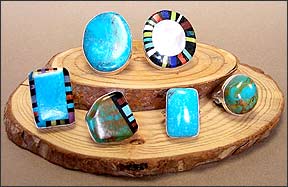Home
About Us
Current News
Event Calendar
Artist Bios
ARCHIVES
Display IDEAS
Collecting Tips
Gen Arts/Crafts Info
Testimonials
Hours/Directions
Online Store
ARCHIVES - Artist / Highlight of the Month
RONALD and PETRA CHAVEZ (Santo Domingo Pueblo) - 2009
The Highlight of the Month program at The Indian Craft Shop focuses on a particular craft area, region or artist family/group. Our aim is to illustrate the diversity of tribal groups and the wide variety of artistic expressions and traditions in the country today.
Ronald and Petra Chavez have been working together since their teens, continuing the centuries old artistic tradition of working with stone and shell to make jewelry. Their exceptional artistry, skill and patience combine to create exquisite turquoise and heishi necklaces, pendants, earrings, rings and pins. Their jewelry has the classic look of the past with a contemporary spirit of today.
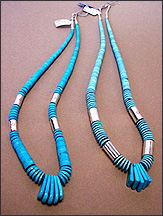
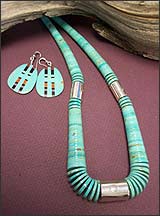
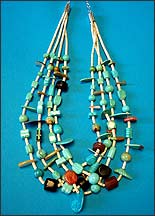
The tradition of making jewelry from stone and shell is one of the oldest in North America. The word "heishi" means "shell bead" in the Keres language spoken at Santo Domingo Pueblo and specifically refers to pieces of shell which have been drilled, made into beads and then strung into necklaces. Olive shell, mother of pearl, melon shell, clam shell, pen shell, abalone, and the red, yellow, orange and purple spiny oyster shells were gathered in trade from what is now California up to the Pacific Northwest and from Mexico down through South America. Today, outside of the Santo Domingo Pueblo, "heishi" is often used to refer to any small hand-made beads made of stone or shell.
Historically, artisans from the Santo Domingo Pueblo had easy access to turquoise and gained a reputation for making fine turquoise jewelry and heishi. Ronald and Petra are among many who keep that reputation alive today. Both come from jewelry-making families where creating handmade beads was a part of everyday family life. As young children, they learned the steps of making beads, helping sort and string the beads and later to shape the beads on their own.
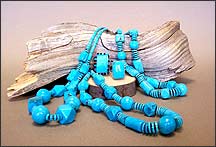
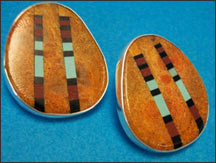
Creating their jewelry is labor intensive and requires great patience and time. The shells or stone are sliced into square then octagonal shapes. A small hole is drilled into each piece which is then strung on fine wire. Then the critical work of shaping begins with expert skills required for grinding. The final beads are sanded and buffed to a high shine. A finished necklace is smooth and slips gracefully through the fingers.
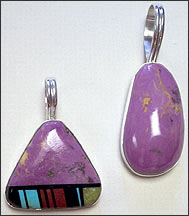
In addition to the shaped bead necklaces, Ronald and Petra make necklaces with graduated and tapered wafer cut beads, tab necklaces, jocla and nugget necklaces in turquoise, jet, pipestone, serpentine and shell. Some necklaces may be delicate and sleek, others may be chunky and bold with big round beads and other geometric shapes. Ronald has also learned to work with silver and incorporates silver drum beads into their necklaces. Others may include elegant inlaid strips of mosaic work with colorful stones or sculpted beads. Their treasure necklaces are amazing, showcasing all of their skills, styles and materials in a dramatic one-of-a-kind necklace.
The mosaic inlay work is another ancient technique. Pieces of shell and stone are overlaid on a base, traditionally shell or cottonwood, then ground to a smooth surface, sanded and buffed. Sunflower sap was used for glue in the past; today epoxy is used. Ronald and Petra use their mosaic work in their necklaces, rings, pendants and earrings.
The simplicity of design and materials used make their work stand out. The beauty of the stones dictate the shapes of their slab earrings and stone pendants although some may be gently sculpted, carved into a graceful leaf or feather. The settings are simple so they do not detract from the shape and color of the stones. Their slab earrings come in a range of sizes and in a variety of colors of turquoise, some with bands of mosaic inlay, but each perfectly matched. In 1997, The School of American Research in Santa Fe honored Petra and Ronald, interviewing them and acquiring their work for their permanent collection.
Ronald and Petra enjoy this traditional style of jewelry making and it is their hope that people may enjoy and treasure it for years to come.
©The Indian Craft Shop 2006


